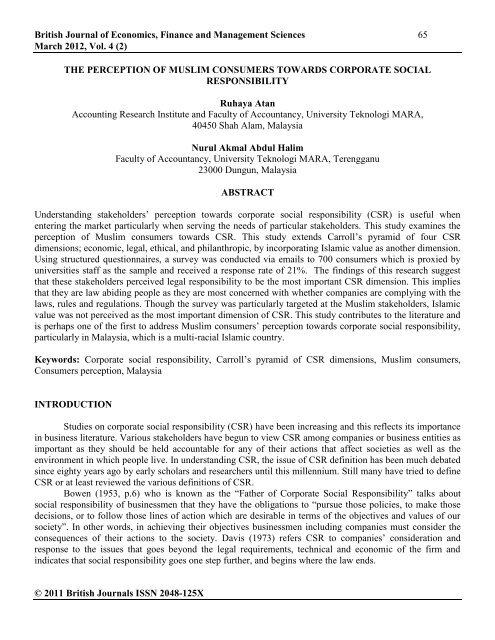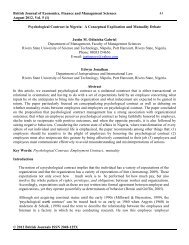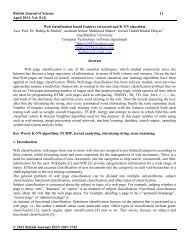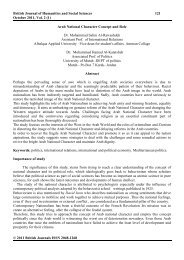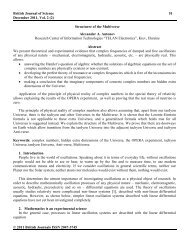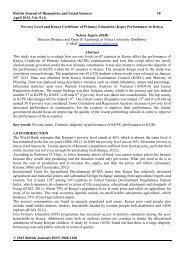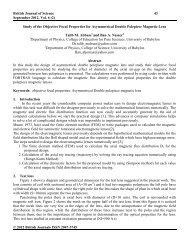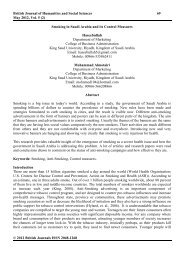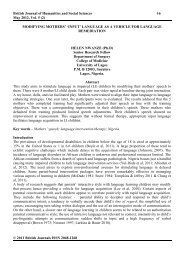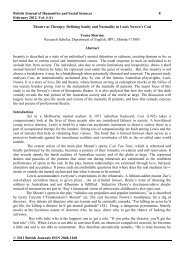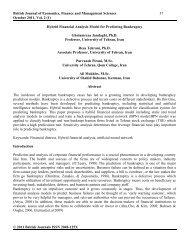the perception of muslim consumers towards corporate social ...
the perception of muslim consumers towards corporate social ...
the perception of muslim consumers towards corporate social ...
Create successful ePaper yourself
Turn your PDF publications into a flip-book with our unique Google optimized e-Paper software.
While <strong>the</strong> probability parameters (a ij), π 1 and π 2 are initializedconventionally using uniform distributions [14], <strong>the</strong> state means areinitialized as µ 1 = max(E n) and µ 2 = min(E n). For <strong>the</strong> varianceparameters, <strong>the</strong> initialization σ 2 1 = σ 2 2 = R · var(E n) with R = 0.1has been found to yield satisfactory results. From <strong>the</strong>se initial values,<strong>the</strong> HMM parameters are estimated in a typical fashion usingan implementation <strong>of</strong> <strong>the</strong> EM re-estimation principle [14].During each iteration, <strong>the</strong> EM algorithm estimates <strong>the</strong> probabilitydistribution (γ n(1), γ n(2)) for being in state 1 or state 2 attime instant n. To convert <strong>the</strong>se values to a segmentation in terms<strong>of</strong> <strong>the</strong> two states, we simply take X n = 1 if γ n(1) ≥ γ n(2) andX n = 0 o<strong>the</strong>rwise, for all n. The EM re-estimation is deemed tohave converged and <strong>the</strong> iteration is stopped once this segmentationX n does not change between two successive EM iterations. Sincestate 1 was initialized with <strong>the</strong> maximal value and state 2 with <strong>the</strong>minimal value, we can safely assume that state 1 will be <strong>the</strong> “highstate” for <strong>the</strong> frame energy time series. The additional benefit <strong>of</strong> usingan HMM for this purpose instead <strong>of</strong> simple unsupervised thresholddetermination is that <strong>the</strong> HMM smoo<strong>the</strong>s <strong>the</strong> segmentation intime. All successive processing for <strong>the</strong> block is done using only<strong>the</strong> high-state frames for which X n = 1. Modeling and recognizingonly <strong>the</strong>se high-energy frames is justifiable because <strong>the</strong>se framespresumably have <strong>the</strong> best local SNR. Fig. 3 shows <strong>the</strong> evolution <strong>of</strong><strong>the</strong> state segmentation X n with EM iterations for a noisy (SNR 0 dBfactory noise) two-second speech segment.E nX niteration 1X niteration 2X niteration 3Fig. 3. Evolution <strong>of</strong> HMM segmentation with EM iterations for <strong>the</strong>log energy sequence <strong>of</strong> a noisy speech segment.2.4. GMM classificationThe classifier uses a specialized GMM to model each <strong>of</strong> <strong>the</strong> threeprimary classes: <strong>the</strong> noise environment, normal speech (both maleand female) and shouting (both male and female). These GMMsλ environment, λ speech and λ shout have 8 mixture components witha diagonal covariance structure [15]. For initializing <strong>the</strong> componentmean vectors <strong>of</strong> <strong>the</strong> GMMs, <strong>the</strong> simple heuristic approach proposedin [16] is used. The variances <strong>of</strong> each variable in each componentare initialized by 0.1 times <strong>the</strong> variable’s global variance over <strong>the</strong>training data. The mixture weights are initialized with uniform distributions.Each GMM is trained by running four EM iterations [15].For <strong>the</strong> number <strong>of</strong> mixture components in each model, both 8 and16 were evaluated and <strong>the</strong> former was selected because it providedslightly better performance.When <strong>the</strong> GMMs are used in detection, <strong>the</strong> audio signal is processedin blocks <strong>of</strong> two seconds, with a block shift <strong>of</strong> one second.After <strong>the</strong> high-energy frames have been selected using <strong>the</strong> HMMframe dropping detailed in Section 2.3, <strong>the</strong> averaged log likelihoods<strong>of</strong> <strong>the</strong>m having been produced by each <strong>of</strong> <strong>the</strong> three GMMs are computedand denoted as L shout , L speech and L environment. The shoutingdetection is considered as a binary classification problem andtreated according to <strong>the</strong> Bayes rule. The logarithmic likelihood ratiodecision statistic is defined as L = L shout − L nonshout . The shoutscore is <strong>the</strong> shout GMM likelihood and <strong>the</strong> non-shout score is obtainedas <strong>the</strong> maximum <strong>of</strong> <strong>the</strong> speech and noise GMM likelihoodsas L nonshout = max(L speech , L environment). For each detectionblock, <strong>the</strong> statistic L can be recorded and used in evaluating <strong>the</strong> systemperformance with variable detection threshold.3. EXPERIMENTAL EVALUATION3.1. Test material and setupTo represent different types <strong>of</strong> acoustic environments, two types <strong>of</strong>noise from <strong>the</strong> NOISEX-92 database were used. The factory1 noisecontains machine noise with frequent transient impulsive sounds.The babble noise contains many people talking simultaneously ina cafeteria-like environment.The speech and shouting was recorded with high quality equipmentin an anechoic chamber. The data consists <strong>of</strong> 11 male and 11female speakers, each speaking 24 Finnish sentences, both in a normalfashion and by shouting. The shouting was controlled both bylistening and by monitoring <strong>the</strong> sound pressure level. A mere raisedvoice was not accepted as shouting. Twelve <strong>of</strong> <strong>the</strong> sentences aresentences in <strong>the</strong> imperative mood, consisting <strong>of</strong> one to four Finnishwords, with a message that could plausibly be uttered in a potentiallythreatening situation, such as “anna se kamera tänne” (“give me <strong>the</strong>camera”), “älkää liikkuko” (“don’t move”) and “lopettakaa” (“stopit”). The o<strong>the</strong>r 12 sentences consist <strong>of</strong> three Finnish words, are in<strong>the</strong> indicative mood and have a neutral, abstract information content.The experiments were carried out as leave-one-out cross validation.Each speaker in turn was selected as <strong>the</strong> test speaker, and datafrom <strong>the</strong> o<strong>the</strong>r 21 speakers was used to train <strong>the</strong> speech and shoutmodels. The test material for each speaker consisted <strong>of</strong> that speaker’sspeech and shout material, both corrupted by noise with a given segmentalor frame-averaged SNR, as well as a segment <strong>of</strong> noise equalin length to <strong>the</strong> speaker’s combined speech and shout material. Thenoise model was trained using two minutes <strong>of</strong> <strong>the</strong> noise material,while <strong>the</strong> remaining portion <strong>of</strong> <strong>the</strong> noise recording was used for testing.The primary measure to assess <strong>the</strong> performance is <strong>the</strong> equalerror rate (EER), a common metric to assess <strong>the</strong> quality <strong>of</strong> a twoclassdetector. The EER corresponds to <strong>the</strong> decision threshold forwhich <strong>the</strong> miss and false alarm rates are equal.3.2. ResultsTables 1 and 2 show <strong>the</strong> shout detection results for <strong>the</strong> NOISEX-92factory1 and babble noises, respectively. In <strong>the</strong> case <strong>of</strong> 12 MFCCs,results are also shown by using only <strong>the</strong> LP or WLP spectrum envelopewithout <strong>the</strong> excitation spectrum. The usefulness <strong>of</strong> including<strong>the</strong> excitation spectrum is easily observed. Several different types<strong>of</strong> features give good performance at low to moderate noise levels.However, at SNR levels -10 dB and -20 dB, at which <strong>the</strong> systemperformance is degrading rapidly, <strong>the</strong> most resistant features are 30MFCCs obtained using LP or WLP envelope combined with <strong>the</strong> excitationspectrum.
British Journal <strong>of</strong> Economics, Finance and Management Sciences 69March, Vol. 4 (2)understanding what stakeholders‟ wants will placed companies at risk. Hence, it is crucial to understand what<strong>the</strong>y expect from companies. In addition, developing companies to be <strong>social</strong>ly responsible throughperforming <strong>social</strong> activities could also be seen as part <strong>of</strong> a strategic plan in managing stakeholderrelationships.As mentioned earlier, many <strong>of</strong> previous studies explain CSR from <strong>the</strong> companies‟ <strong>perception</strong>. Only asmall number <strong>of</strong> studies look at <strong>consumers</strong>‟ <strong>perception</strong> <strong>towards</strong> CSR (Auger et al., 2003; Dusuki & TengkuMohd Yus<strong>of</strong>, 2008; Maignan, 2001; Ramasamy & Yeung, 2009) and none <strong>of</strong> those studies focus onMuslims‟ <strong>perception</strong>. Therefore this study aimed to look at Muslim <strong>consumers</strong>‟ <strong>perception</strong> <strong>towards</strong> CSR.This is in line with more recent efforts <strong>towards</strong> examining CSR concepts from an Islamic perspective, sincemost <strong>of</strong> <strong>the</strong> previous literature points to CSR emergence in <strong>the</strong> west. Specifically, <strong>the</strong> objectives <strong>of</strong> this studyis to identify Muslim <strong>consumers</strong>‟ <strong>perception</strong> <strong>towards</strong> CSR based on five CSR dimensions namely, economic,legal, ethical, philanthropic and Islamic value.Studies on <strong>perception</strong> <strong>towards</strong> CSRThere have been many studies on <strong>perception</strong> <strong>towards</strong> CSR that include general <strong>perception</strong> <strong>towards</strong>CSR and <strong>perception</strong> based on Carroll‟s pyramid <strong>of</strong> CSR which are summarized below. Among <strong>the</strong> earlieststudy <strong>of</strong> stakeholders‟ <strong>perception</strong> is by Holmes (1976). The study found that <strong>the</strong> respondents (<strong>corporate</strong>executives) believed that <strong>the</strong> opinion and philosophies <strong>of</strong> <strong>the</strong>ir companies have changed significantly duringthat period and <strong>the</strong>y were highly optimistic on <strong>the</strong> companies‟ <strong>social</strong> role to <strong>the</strong> society because <strong>the</strong>y believethat companies‟ involvement in <strong>social</strong> responsibility would provide positive outcomes to <strong>the</strong> companies suchas increasing <strong>corporate</strong> reputation and goodwill.Brown and Dacin (1997) in <strong>the</strong>ir study used two activities (which somewhat did not represent all CSRactivities) to induce <strong>corporate</strong> <strong>social</strong> responsibility associations by identifying companies who were involvedand contributed to <strong>the</strong> society. They found that negative <strong>corporate</strong> responsibility associations providednegative effect on overall product evaluation whereas positive <strong>corporate</strong> responsibility associations enhancedproduct evaluations. This study also showed that <strong>corporate</strong> reputation affects <strong>consumers</strong>‟ productevaluations.Creyer (1997) survey 280 parents in North Eastern <strong>of</strong> USA on <strong>the</strong>ir purchase intention from ethicalcompanies and found that parents perceived ethical behavior <strong>of</strong> a company as <strong>the</strong> most important factor to beconsidered before making buying decisions. Similarly, Auger, Devinney & Louviere (2003) found thatethical issues faced by a company influenced <strong>consumers</strong>‟ purchase decisions indicating that <strong>consumers</strong>placed high priority on <strong>the</strong> selection <strong>of</strong> ethical companies when making a purchase decision. Page and Fearn(2005) in <strong>the</strong>ir study on around 22,000 <strong>consumers</strong> in <strong>the</strong> United Kingdom and USA and 5,800 <strong>consumers</strong> inJapan however, found that 70 percent <strong>of</strong> <strong>the</strong> <strong>consumers</strong> in <strong>the</strong> United Kingdom, 64 percent in <strong>the</strong> USA and65 percent in Japan, considered price and quality <strong>of</strong> products as most important compared to <strong>the</strong> ethicalbehavior <strong>of</strong> <strong>the</strong> companies.There are many studies on <strong>perception</strong>s <strong>towards</strong> CSR based on Carroll‟s pyramid (see for exampleRamasamy & Yeung, 2009; Dusuki & Tengku Mohd Yus<strong>of</strong>, 2008; Ibrahim & Parsa, 2005; Smith et al, 2004;Ibrahim et al, 2003; Maignan & Ferrell, 2003; Smith et al, 2001; Edmundson & Caroll, 1999; Ibrahim &Angelidis, 1995, 1993). Findings <strong>of</strong> those studies place economic dimension as <strong>the</strong> most importantcomponent <strong>of</strong> CSR followed by legal, ethical, and philanthropic dimension respectively. It could beconcluded that <strong>the</strong> ranking <strong>of</strong> CSR dimensions by various stakeholders are consistent with that <strong>of</strong> Carroll‟spyramid.In more recent years <strong>the</strong>re have also been studies on CSR <strong>perception</strong>s and awareness in Malaysia and<strong>the</strong>y are summarized in Table 1 below.© 2011 British Journals ISSN 2048-125X
British Journal <strong>of</strong> Economics, Finance and Management Sciences 70March, Vol. 4 (2)Table 1: Summary <strong>of</strong> studies on CSR <strong>perception</strong>s and awareness in MalaysiaYear Authors Respondents Findings2002 Abdul Rashid &IbrahimMalaysian managersand executivesMajority <strong>of</strong> Malaysian managers andexecutives have positive view on <strong>the</strong>involvement <strong>of</strong> companies in <strong>social</strong>lyresponsible activities but <strong>the</strong>ir involvementin CSR activities was low. Mostcompanies involved in CSR activitiesinformed <strong>the</strong> general public <strong>of</strong> <strong>the</strong>ir2004 Ramasamy & Ting MBA students fromNottinghamUniversity BusinessSchool registered inMalaysia andSingapore.2006 Zulkifli & Amran Accountingpr<strong>of</strong>essionalsinvolved in <strong>the</strong>preparation <strong>of</strong>annual report for <strong>the</strong>company2008 Dusuki & TengkuMohd Yus<strong>of</strong>Public and privateuniversity studentslocated in Selangorused as proxy torepresent <strong>consumers</strong>.2009 Amran & Abdul Khalid Selected Malaysianmanager <strong>of</strong> listedcompanies.<strong>social</strong>ly responsible activities.Respondents from Singaporean companieswere more CSR conscious compared to <strong>the</strong>respondents from Malaysian companies.The difference could be due <strong>the</strong> economicdevelopment in <strong>the</strong>se two countries thatinfluenced <strong>the</strong>ir awareness <strong>towards</strong> CSR.Overall results found that accountingpr<strong>of</strong>essionals lack <strong>of</strong> understanding andawareness <strong>of</strong> <strong>the</strong> concept <strong>of</strong> CSR. Thestudy suggests that education would be <strong>the</strong>best way in enhancing CSR awarenessamong accounting pr<strong>of</strong>essionals.In terms <strong>of</strong> CSR function, some <strong>of</strong>interviewee stated that CSR is an importantcommunication channel to disseminateinformation <strong>of</strong> company‟s <strong>social</strong> obligationto <strong>the</strong> public to promote a company as aresponsible business entity.The study found that Malaysianstakeholders perceived economic as <strong>the</strong>most important dimension, followed by <strong>the</strong>ethical, legal and philanthropicdimensions.The result was slightly different from <strong>the</strong>original dimensions proposed by Carroll‟sdue to <strong>the</strong> difference in culture factor thatmay have influence <strong>the</strong> Malaysianstakeholder‟ <strong>perception</strong> <strong>towards</strong> CSRdimensions.Level <strong>of</strong> awareness <strong>towards</strong> CSR from <strong>the</strong>employees‟ perspective was still at <strong>the</strong>lower level even though <strong>the</strong>re was anincreasing trend by companies‟involvement in CSR activities and CSR© 2011 British Journals ISSN 2048-125X
British Journal <strong>of</strong> Economics, Finance and Management Sciences 71March, Vol. 4 (2)disclosure. The increasing trend <strong>of</strong>reporting CSR could be due to <strong>the</strong>expectation that <strong>the</strong> companies will beaccepted as <strong>the</strong> international players.From Table 1, it can be summarized that <strong>the</strong> level <strong>of</strong> awareness on <strong>the</strong> importance <strong>of</strong> CSR among <strong>the</strong>stakeholders in Malaysia are still low even though managers and executives are supportive <strong>of</strong> companies‟involvement in CSR activities. One study shows that stakeholders in Malaysia perceived economicdimension as <strong>the</strong> most important dimension based on Carroll‟s model <strong>of</strong> CSR dimensions. Overall, study on<strong>perception</strong> <strong>towards</strong> CSR in Malaysia is still limited and hence <strong>the</strong> motivation for this study.Islamic perspective on CSRIn Islam, features <strong>of</strong> <strong>social</strong> responsibility and justice are deeply rooted in <strong>the</strong> Qur’an and Hadith –exemplifying <strong>the</strong> Sunnah <strong>of</strong> <strong>the</strong> holy Prophet Mohammed (PBUH) 1 (Mohammed, 2007). Similarly,companies are considered as having <strong>the</strong> responsibility to o<strong>the</strong>rs including society and <strong>the</strong> environment. Thereason being companies as separate entities, are considered as having a relationship with Allah, relationshipwith o<strong>the</strong>r human beings and relationship with <strong>the</strong> environment. Hence, companies need to comply with <strong>the</strong>Islamic rules and regulations in order for <strong>the</strong>ir activities to be blessed (barakah) by Allah (Muwazir,Muhamad & Noordin, 2006).One <strong>of</strong> <strong>the</strong> <strong>social</strong> dimensions <strong>of</strong> all Muslims including companies is payment <strong>of</strong> zakat. Zakat refers to<strong>the</strong> contribution <strong>of</strong> a proportion <strong>of</strong> <strong>the</strong> wealth to be distributed to <strong>the</strong> poor and needy as sanctification for <strong>the</strong>remainder <strong>of</strong> <strong>the</strong> property (Metwally, 1997; Muwazir et al., 2006; Rice, 1999). In Islam, all Muslims whohave extra wealth are obliged to pay zakat as it is one <strong>of</strong> <strong>the</strong> five pillars <strong>of</strong> Islam. This has been stated in one<strong>of</strong> <strong>the</strong> Qur’an verses:“...<strong>of</strong> <strong>the</strong>ir wealth take alms, so that you might purify and sanctify <strong>the</strong>m...”(Quran, Sura At-Taubah-10:103 (Basmeih, 1999))The payment <strong>of</strong> zakat can help in balancing <strong>the</strong> economy <strong>of</strong> a country since <strong>the</strong> poor and needy couldhave a better life (Omar, 1999). By this way, <strong>the</strong> payment <strong>of</strong> zakat could assist companies to fulfill <strong>the</strong>irresponsibility to Allah as well as to <strong>the</strong> society as a whole. Sadaqa is ano<strong>the</strong>r <strong>social</strong> dimension in Islamwhere companies could make contribution to <strong>the</strong> o<strong>the</strong>rs in term <strong>of</strong> giving donations. The donation can begiven in terms <strong>of</strong> money to help <strong>the</strong> poor, needy person and orphans or building <strong>of</strong> public facilities likesmosque, public hall and recreational park (Yassin, 1999). These donations can also benefit <strong>the</strong> society as awhole. In short, <strong>social</strong> responsibility activities; zakat and sadaqah can help us to get baraqah (blessing) fromAllah and at <strong>the</strong> same time <strong>the</strong> ‘amal salih (good deeds) is <strong>the</strong> key to <strong>the</strong> attainment <strong>of</strong> al-falah (success in<strong>the</strong> world and hereafter).Islam also promotes environmental protection because all <strong>of</strong> Allah‟s creations have value and Allahdislikes those that are not responsible in protecting and preserving <strong>the</strong> environment and natural resources(Mat, 1999). This is stated in Sura Al Qasas-20:77, (Basmeih, 1999); “…don‟t you do any mischief on <strong>the</strong>earth as Allah dislikes those that make <strong>the</strong> destruction on <strong>the</strong> earth”. This means that any abuse, misuse,destruction and pollution <strong>of</strong> natural resources as well as <strong>the</strong> environment are all transgression against <strong>the</strong>divine scheme. In order to ensure that <strong>the</strong> natural resources and <strong>the</strong> environment are protected, everyone1PBUH – Peace and Blessings be upon him – generally mentioned along with <strong>the</strong> holyProphet Mohammed’s name.© 2011 British Journals ISSN 2048-125X
British Journal <strong>of</strong> Economics, Finance and Management Sciences 72March, Vol. 4 (2)including business organizations have to take <strong>the</strong> necessary actions so that future generations can also live inclean and healthy environment.Lewis (2001) notes that <strong>the</strong> implications <strong>of</strong> companies from Islamic perspective is that both managersand providers <strong>of</strong> capital are accountable for <strong>the</strong>ir actions both inside and outside <strong>of</strong> <strong>the</strong>ir firms.Accountability in this context refers to accountability to <strong>the</strong> community or society at large to establish socioeconomicjustice within <strong>the</strong>ir own capacity (Lewis, 2001; Susela & Muhammad, 2004). Examples <strong>of</strong> socioeconomicjustice from <strong>the</strong> Islamic point <strong>of</strong> view are obligatory payment out <strong>of</strong> income and wealth (zakat),philanthropic trust (waqf) and charity (sadaqa) (Zinkin, 2007). Mohammed (2007) explained that Islamcommands its followers to adhere to <strong>the</strong> same unified code <strong>of</strong> behavior in <strong>the</strong> life <strong>of</strong> mankind, and that everyaction <strong>of</strong> mankind is for Allah (TME) 2 , it is only Allah (TME) to be feared, and thus morality followsautomatically. As in Sura Al An‟am-6:162 (Basmeih, 1999);“Say: Lo! My worship and my sacrifice and my living and my dying are all for Allah, Lord <strong>of</strong> <strong>the</strong>Worlds”Because <strong>of</strong> this philosophy, one becomes selfless and conscious about <strong>social</strong> responsibility andjustice. Therefore <strong>the</strong> Qur’an and Hadith <strong>of</strong> <strong>the</strong> holy Prophet (PBUH) demonstrate <strong>the</strong> significance <strong>of</strong> <strong>the</strong>concept <strong>of</strong> <strong>social</strong> responsibility and justice having a connection with righteousness in Islam; and that moralitythat reflects <strong>social</strong> responsibility and justice in Islam as <strong>the</strong> foundation <strong>of</strong> an Islamic society (Mohammed,2007). One example is evidenced in <strong>the</strong> holy Qur’an “... give full measure when you measure, and weighwith a balance that is true…” (Qur‟an, Sura Al Israa-17: 35 (Basmeih, 1999)). This indicates that morality orethical value is greatly emphasized in Islam. In Islamic ethics, Muslims have to guide <strong>the</strong>ir behavior, deeds,words, feelings, thoughts and intensions <strong>towards</strong> <strong>the</strong> good value such as truthfulness, kindness and respect <strong>of</strong><strong>the</strong> law. Islam also asks its believers to observe certain norms and moral codes and comply with <strong>the</strong> Islamicrules and regulations in <strong>the</strong>ir family affairs, in <strong>the</strong>ir business transactions, in <strong>the</strong>ir <strong>social</strong> affairs and in dealingwith o<strong>the</strong>rs. Obedience to ethical behavior is part <strong>of</strong> Iman (faith) and as such, <strong>social</strong> responsibility and justiceis considered as an <strong>of</strong>fshoot <strong>of</strong> <strong>the</strong> Muslim belief system (Mohammed, 2007).A body <strong>of</strong> <strong>the</strong> CSR literature has examined <strong>the</strong> link between CSR and religiosity which implies thatreligiosity could influence individuals‟ preference <strong>towards</strong> CSR dimensions. Religiosity played an importantdeterminant to a given ethical scenario, (Conroy & Emerson, 2004), and highly religious groups <strong>of</strong> peoplehave higher concern on ethical dimension <strong>of</strong> CSR and a weaker orientation <strong>towards</strong> economic dimension <strong>of</strong>CSR (Angelidis and Ibrahim, 2004) Similarly, Dusuki and Tengku Mohd Yus<strong>of</strong> (2008) also found highlyreligious groups <strong>of</strong> people would place more value to legal, ethical and philanthropic dimension and lessweight on economic dimension. Contrary, Agle and Van Buren III (1999) found marginal support on <strong>the</strong>relationship between religiosity and positive attitude <strong>towards</strong> CSR where majority <strong>of</strong> <strong>the</strong> respondents did notconsider religion as an influencing factor in <strong>the</strong>ir attitudes <strong>towards</strong> CSR.Studies have suggested that Islamic value in particular, plays an important role in influencingstakeholders‟ <strong>perception</strong> <strong>towards</strong> CSR (Angelidis & Ibrahim, 2004; Arslan, 2001; Zulkifli & Amran, 2006)).There has yet to be a study on religious value using Carroll‟s pyramid <strong>of</strong> CSR. Therefore, this study extendsCarroll‟s model <strong>of</strong> CSR by including Islamic value as part <strong>of</strong> CSR dimensions. Islamic values that relate toCSR as explained above is taken as a separate dimension, though some <strong>of</strong> <strong>the</strong>se values are also considered asethical or philanthropic responsibilities. Islamic values comes with <strong>the</strong> believe in Allah and Rasullah.RESEARCH METHODThe research is based on a survey <strong>of</strong> Muslim <strong>consumers</strong> that were proxied by Muslim universitystaffs from three big public universities in <strong>the</strong> capital state <strong>of</strong> Kelantan. University staffs were selected2TME – The Most Exalted – generally mentioned with Allah’s name.© 2011 British Journals ISSN 2048-125X
British Journal <strong>of</strong> Economics, Finance and Management Sciences 73March, Vol. 4 (2)because it is assumed that <strong>the</strong>y represent educated <strong>consumers</strong> and would be well informed about a range <strong>of</strong>issues related to <strong>consumers</strong> which may likely influence <strong>the</strong>ir <strong>perception</strong> on CSR (Wong, Loh & Yap, 2009).State <strong>of</strong> Kelantan was selected because it has a majority population <strong>of</strong> Malays 3 which represents 95 percent 4<strong>of</strong> total population <strong>of</strong> Kelantan. The Malays practice <strong>the</strong> religion <strong>of</strong> Islam in <strong>the</strong>ir way <strong>of</strong> life. Kelantan isalso ruled by <strong>the</strong> Islamic opposition party; which implies that Kelantanese people would be more concernedwith Islamic values in <strong>the</strong>ir daily life.InstrumentationA questionnaire was designed to elicit information from <strong>the</strong> participants. The first section <strong>of</strong> <strong>the</strong>questionnaire consisted <strong>of</strong> questions that capture <strong>the</strong> respondent‟s demographic pr<strong>of</strong>ile, such as age, gender,working experience and education level. The second section comprised 26 statements related to respondent‟ssupport for <strong>social</strong>ly responsible companies and <strong>the</strong>ir <strong>perception</strong> on <strong>the</strong> five dimensions <strong>of</strong> CSR. All questionsin <strong>the</strong> second section was presented in <strong>the</strong> form <strong>of</strong> Likert-scale statements, each with five choices <strong>of</strong>responses from 1 (strongly disagree) to 5 (strongly agree). Consumers support <strong>towards</strong> <strong>social</strong>ly responsiblecompanies was measured using 10 items on religious belief and <strong>the</strong> remaining 16 items were categorized int<strong>of</strong>our main dimensions <strong>of</strong> CSR; economic, legal, ethical, and philanthropic. The questionnaire was adaptedfrom Ramasamy and Yeong (2009) with modification to include religious belief, to suit <strong>the</strong> objectives <strong>of</strong> thisstudy.A total <strong>of</strong> 700 questionnaires were distributed via email. Three follow-up emails were sent as kindreminder to <strong>the</strong> universities‟ staff inviting <strong>the</strong>m to participate and complete <strong>the</strong> questionnaire before <strong>the</strong>dateline. In total 164 questionnaires were returned to <strong>the</strong> researchers, a gross response <strong>of</strong> 23.42 percent butonly 145 were usable reducing <strong>the</strong> response rate to 20.71 percent only.Reliability Analysis and Content ValidityA Cronbach Alpha test was also performed to determine <strong>the</strong> reliability <strong>of</strong> questionnaire instrument. Ageneral rule is <strong>the</strong> indicators should have a Cronbach‟s Alpha <strong>of</strong> 0.6 or more (Nunnally, 1978). The analysison <strong>the</strong> 26 items in <strong>the</strong> questionnaire shows a Cronbach‟s Alpha <strong>of</strong> 0.931 and Cronbach‟s Alpha Based onStandardized Items <strong>of</strong> 0.937; which indicates that <strong>the</strong> internal consistency <strong>of</strong> constructs for all 26 items in <strong>the</strong>questionnaire is reliable.Factor analysis was carried out to determine <strong>the</strong> content validity <strong>of</strong> all statements in <strong>the</strong> questionnaire.This test is important to determine whe<strong>the</strong>r items are tapping into <strong>the</strong> same construct (Coakes et al., 2009). Itis used to ga<strong>the</strong>r information about <strong>the</strong> inter-relationships among a set <strong>of</strong> variables (Pallant, 2003). However,no comparison can be made with <strong>the</strong> previous study since this is a first study that includes <strong>the</strong> Islamic valueas part <strong>of</strong> CSR dimensions to examine Muslim stakeholders‟ <strong>perception</strong> <strong>towards</strong> CSR.The principal axis factor analysis with varimax rotation was conducted to access <strong>the</strong> underlyingstructure for <strong>the</strong> questionnaire items. The Kaiser-Meyer-Oklin (KMO) value was 0.785, exceeding <strong>the</strong>recommended value <strong>of</strong> 0.06 (Coakes et al., 2009; Pallant, 2003) and <strong>the</strong> Bartlett‟s Test <strong>of</strong> Sphericity reachedstatistical significance <strong>of</strong> less than 0.05, indicating that <strong>the</strong> correlation matrix is significantly different froman identity matrix, in which correlations between variables are all zero. This means that statements used in<strong>the</strong> questionnaire are valid. The result <strong>of</strong> KMO and Bartlett‟s Test is provided in Table 2.3By Article 160 (2) <strong>of</strong> <strong>the</strong> Constitution <strong>of</strong> Malaysia (2006), Malays are Muslims.4Source: http://www.tic.kelantan.gov.my© 2011 British Journals ISSN 2048-125X
British Journal <strong>of</strong> Economics, Finance and Management Sciences 74March, Vol. 4 (2)© 2011 British Journals ISSN 2048-125XTable 2: Result <strong>of</strong> KMO and Bartlett's TestKaiser-Meyer-Olkin Measure <strong>of</strong> Sampling Adequacy..785Bartlett's Test <strong>of</strong> Sphericity Approx. Chi-Square 1981.706df 325Sig. .000Result <strong>of</strong> factor analysis shows factor loading for each item <strong>of</strong> between 0.911 and 0.321. Factorloadings <strong>of</strong> 0.30 are considered to meet <strong>the</strong> minimal level; factor loadings <strong>of</strong> 0.40 are considered moreimportant; and any factor loadings <strong>of</strong> 0.50 or greater are considered practically significant (Hair, Anderson,Tatham and Black (1998). As <strong>the</strong> minimum factor loadings <strong>of</strong> <strong>the</strong> item is 0.321, this means that all factorloadings for this study meet <strong>the</strong> minimum level.Participants‟ Pr<strong>of</strong>ileFrom <strong>the</strong> total <strong>of</strong> 145 participants <strong>of</strong> <strong>the</strong> survey, 66 respondents came from UiTM (46 percent), 58 (40percent) from UMK, and 21 (14 percent) from USM. Table 3 shows <strong>the</strong> demographic pr<strong>of</strong>ile <strong>of</strong> respondents.The majority <strong>of</strong> respondents are female (62.76 percent). Most <strong>of</strong> <strong>the</strong>m fall between <strong>the</strong> age <strong>of</strong> 31 to 40 yearsold (38.62 percent), followed by those above 40 years old (31.73 percent), and those between 20-30 years old(29.66 percent). 88 percent <strong>of</strong> <strong>the</strong> respondents have university qualifications <strong>of</strong> at least a bachelor‟s degree.This corresponds with <strong>the</strong> fact that 70.34 percent <strong>of</strong> <strong>the</strong>m are academics while <strong>the</strong> rest are non-academics. Interms <strong>of</strong> working experience, most <strong>of</strong> <strong>the</strong> respondents have more than 10 years experience (43.45 percent),29.66 percent had less than 5 years working experience and 26.9 percent have between 5 to 10 years <strong>of</strong>experience. The analysis shows that majority <strong>of</strong> respondents are educated, with years <strong>of</strong> working experienceand hence, matured thinking individuals.Table 3: Demographic pr<strong>of</strong>ile <strong>of</strong> respondentsCategory Frequency PercentGender Male 54 37.24Female 91 62.76Age 20-30 years 43 29.6631-40 years 56 38.6241-50 years 34 23.4551 and above 12 8.28Education Ph.D 23 15.86Master's degree 66 45.52Bachelor's degree 39 26.90Pr<strong>of</strong>essional degree 5 3.45Diploma 5 3.45School Certificate 7 4.83WorkingExperience Less than 5 years 43 29.665-10 years 39 26.9011-20 years 35 24.1421-30 years 23 15.86More than 30 years 5 3.45
British Journal <strong>of</strong> Economics, Finance and Management Sciences 75March, Vol. 4 (2)RESULTS AND ANALYSISThis study surveyed <strong>consumers</strong> <strong>perception</strong> <strong>towards</strong> <strong>the</strong> five dimensions <strong>of</strong> CSR. There are four itemsfor every CSR dimensions. Therefore, <strong>the</strong> possible total composite score for each dimension, namelyeconomic, legal, ethical, philanthropic and Islamic value is between 4 to 20 scores based on Likert scale <strong>of</strong> 1as „strongly disagree‟ to 5 as „strongly agree‟. This means that <strong>the</strong> dimension that obtains nearly 20 meanscore is considered as <strong>the</strong> most important dimension perceived by Muslim stakeholders. Table: 4 presents <strong>the</strong>descriptive statistics which show that legal dimension has <strong>the</strong> highest means score <strong>of</strong> 17.30. Muslimstakeholders in Kelantan perceived legal aspects <strong>of</strong> doing business as <strong>the</strong> most important <strong>corporate</strong>responsibility, followed by philanthropic, economic, Islamic value and ethical dimensions.Table 4: Descriptive Statistics for All CSR DimensionDimension N Minimum Maximum MeanEconomic 145 5 20 16.86Legal 145 4 20 17.30Ethical 145 4 20 16.52Philanthropic 145 5 20 17.09Islamic value 145 5 20 16.63Valid N (listwise) 145These <strong>consumers</strong> are concern most on whe<strong>the</strong>r <strong>the</strong> companies conform to <strong>social</strong> norm that has beenstated in rules and regulations and not only on achieving high economic performance. Since companies arehaving a <strong>social</strong> contract with <strong>the</strong> society, thus Muslim <strong>consumers</strong> in Kelantan expect companies to pursue<strong>the</strong>ir economic missions within <strong>the</strong> framework <strong>of</strong> <strong>the</strong> law. This indicates that <strong>consumers</strong> would perceivecompanies to be good when <strong>the</strong>y comply with <strong>the</strong> rules and regulation. The result <strong>of</strong> this study differs fromCarroll‟s model <strong>of</strong> economic responsibility as <strong>the</strong> most important business responsibility to be productive andpr<strong>of</strong>itable. The results, however, is consistent with Maignan (2001) and Maignan and Ferrell (2003) where<strong>the</strong>y found that French and German <strong>consumers</strong> perceive legal responsibility as <strong>the</strong> most important <strong>corporate</strong><strong>social</strong> responsibility <strong>of</strong> companies.Next important CSR dimension as perceived by <strong>the</strong> respondents is philanthropic responsibility. Thisshows that Muslim stakeholders in Kelantan expect companies to actively contribute to <strong>the</strong> society in order toimprove <strong>the</strong> society‟s quality <strong>of</strong> life. This is perhaps Muslim stakeholders in Kelantan view <strong>the</strong> relationship<strong>of</strong> human being to o<strong>the</strong>r human being as important since Islam commands its followers to help each o<strong>the</strong>respecially to <strong>the</strong> poor and needy (Hashim, 2003; Metwally, 1997; Muwazir et al., 2006). Besides, previousstudies in Malaysia (ACCA, 2004; Amran et al., 2007; Amran & Susela, 2007; Thompson & Zakaria, 2004)found <strong>the</strong> active involvement in philanthropic activities by companies indicates that <strong>the</strong>y recognize <strong>the</strong>importance <strong>of</strong> philanthropic responsibility <strong>of</strong> companies to <strong>the</strong> society as a whole and this has led <strong>consumers</strong>‟including Muslim stakeholders in Kelantan to be more aware on what is expected from companies.The respondents perceived economic responsibility as third important CSR dimension. From <strong>the</strong>Muslim stakeholders‟ point <strong>of</strong> view, particularly in <strong>the</strong> state <strong>of</strong> Kelantan, economic responsibility isconsidered less important even though economic performance is important for <strong>the</strong> companies to maintain astrong competitive position. They believed that companies conforming to <strong>social</strong> norm as more important thanachieving high level <strong>of</strong> economic performance. The result is not consistent with Carroll‟s model (1979,1991), but Smith et al. (2001) found that similarly black and white <strong>consumers</strong> in <strong>the</strong> US ranked economicresponsibility in <strong>the</strong> third place as <strong>the</strong>y placed more emphasis on companies‟ philanthropic responsibility to<strong>the</strong> society.© 2011 British Journals ISSN 2048-125X
British Journal <strong>of</strong> Economics, Finance and Management Sciences 76March, Vol. 4 (2)Islamic responsibility is placed as <strong>the</strong> fourth important dimension perceived by <strong>the</strong> respondents.Though previous studies found that religiosity influenced individuals‟ <strong>perception</strong> <strong>towards</strong> CSR, this studyprovides a contrasting finding. Such result could be attributed to physiological factor where majority <strong>of</strong>stakeholders in Kelantan are Muslims and <strong>the</strong> ruling government in this state is an Islamic political party.Hence Muslim stakeholders in Kelantan believe that Muslims are deemed to practice Islamic religious valuesin <strong>the</strong>ir life as well as <strong>the</strong> non-Muslims businessmen fulfilling for <strong>the</strong> needs <strong>of</strong> majority Muslim <strong>consumers</strong>.As a result, <strong>the</strong>re is less concern on this dimension <strong>of</strong> Islamic value <strong>of</strong> companies.Kelantanese Muslim <strong>consumers</strong> perceived ethical dimension to be <strong>the</strong> least important responsibility tobe considered by companies. Implication <strong>of</strong> this finding is that <strong>consumers</strong> believe that as long as companiescomply with <strong>the</strong> rules and regulations, <strong>the</strong>y are considered to be ethical and hence <strong>consumers</strong> are leastconcerned on this matter. This result is in contrast to Carroll‟s model (1979, 1991) that places philanthropicresponsibility at <strong>the</strong> top <strong>of</strong> <strong>the</strong> pyramid. Previous studies (Edmondson & Carroll, 1999; Ibrahim & Angelidis,1995; Ibrahim et al., 2003; Pinkston & Carroll, 1996; Smith et al., 2001) found that although ethics was notconsidered to be <strong>the</strong> most important goals <strong>of</strong> companies, stakeholders view that being ethical is important forcompanies to maintain <strong>the</strong>ir good reputation.Overall, result <strong>of</strong> <strong>the</strong> survey found that Muslim stakeholders‟ perceived CSR dimensions differently,indicating that none <strong>of</strong> <strong>the</strong>se dimensions have <strong>the</strong> same level <strong>of</strong> importance as proposed in Carroll‟s model <strong>of</strong>CSR and Islamic value is also perceived as not so important as compared to legal responsibility <strong>of</strong> CSR.DISCUSSION AND CONCLUSIONThe focus <strong>of</strong> this study is Muslim <strong>consumers</strong>‟ <strong>perception</strong> <strong>towards</strong> <strong>corporate</strong> <strong>social</strong> responsibility inMalaysia. Understanding <strong>of</strong> such <strong>perception</strong> could assist companies in determining whe<strong>the</strong>r Muslimstakeholders recognize <strong>the</strong> importance <strong>of</strong> CSR so that companies could make strategic plan and takeappropriate actions to ensure <strong>the</strong>ir long term sustainability by meeting customers‟ expectations and demands.Malaysia is a multi-racial country with Malays (being Muslims) as <strong>the</strong> majority (60% <strong>of</strong> <strong>the</strong>population). A survey was conducted in Kelantan where 95 percent <strong>of</strong> its 1,634,200 5 population comprise <strong>of</strong><strong>the</strong> Malay society (<strong>the</strong> Kelantan Tourism Information Center ,2009). Therefore, this study could assistcompanies in obtaining information in identifying whe<strong>the</strong>r religious belief could influence Muslim<strong>consumers</strong> support <strong>towards</strong> <strong>social</strong>ly responsible companies. If <strong>consumers</strong>‟ <strong>perception</strong> <strong>towards</strong> religious valueis high, companies need to ensure that this value is taken into consideration in <strong>the</strong>ir business operation. Thisstudy, however, found that religious dimension was not highly perceived as most important. Muslim<strong>consumers</strong> in Kelantan perceived legal responsibility as <strong>the</strong> most important CSR dimensions. The <strong>consumers</strong>were more concerned about companies conforming to rules and regulation as good citizen and not aboutwhe<strong>the</strong>r companies achieve high levels <strong>of</strong> economic performance or upholding religious or ethical values.The finding <strong>of</strong> this study highlights that <strong>consumers</strong> also expect companies to be actively involved inphilanthropic activities. This is in line with <strong>the</strong> government‟s active role in encouraging companies tocontribute to <strong>the</strong> society. Therefore in order to show support in improving <strong>the</strong> society‟s quality <strong>of</strong> life,companies need to establish clear policy and strategies on how <strong>the</strong>y could help to do this.Since this study focuses only on Muslim <strong>consumers</strong> in Kelantan, generalization <strong>of</strong> <strong>the</strong> findings couldnot be made. Therefore, <strong>the</strong>re is a need for fur<strong>the</strong>r research in this area and for better understanding <strong>of</strong><strong>consumers</strong>‟ behavior <strong>towards</strong> <strong>corporate</strong> <strong>social</strong> responsibilities.5Source: http://www.statistics.gov.my© 2011 British Journals ISSN 2048-125X
British Journal <strong>of</strong> Economics, Finance and Management Sciences 77March, Vol. 4 (2)REFERENCESAbdul Hamid, A., & Ibrahim, F. (2010, March, 22). Muslim NGOs can help check 'Halal' logo abuse. TheStar, p. N6,Abdul Rashid, M. Z., & Ho, J. A. (2003). Perceptions <strong>of</strong> Business Ethics in a Multicultural Community: TheCase <strong>of</strong> Malaysia Journal <strong>of</strong> Business Ethics, 43, 75-87.Abdul Rashid, M. Z., & Ibrahim, S. (2002). Executive and Management Attitudes <strong>towards</strong> Corporate SocialResponsibility in Malaysia. Corporate Governance, 2,4, 10-16.Agle, B. R., & Van Buren III, J. H. (1999). God and Mammon: The Modern Relationship Business EthicsQuarterly, 9(4), 563-582.Amran, A., and Abdul Khalid, S.N. (2009). Corporate Social Reporting in Malaysia: A Case <strong>of</strong> Micmiking<strong>the</strong> West and Succuming to Local Pressure. Social Responsibility Journal, 5 (3), 358-375.Angelidis, J., & Ibrahim, N. (2004). An Exploratory Study <strong>of</strong> <strong>the</strong> Impact <strong>of</strong> Degree <strong>of</strong> Religiousness Upon anIndividual‟s Corporate Social Responsiveness Orientation. Journal <strong>of</strong> Business Ethics, 51, 119-128.Arslan, M. (2001). The Work Ethic Values <strong>of</strong> Protestant British, Catholic Irish and Muslim TurkishManagers. Journal <strong>of</strong> Business Ethics, 31(4), 321-339.Auger, P., Devinney, T. M., & Louviere, J. J. (2003). What Will Consumer Pay for Social Product Features.Journal <strong>of</strong> Business Ethics, 42, 281-304.Basmeih, S. A. (1999). Tafsir Pimpinan AR-RAHMAN Kepada Pengertian AL-QURAN: 30 JUZ (10th ed.).Kuala Lumpur: Percetakan Yayasan Islam Terengganu Sdn. Bhd.Bowen, H. R. (1953). Social Responsibility <strong>of</strong> <strong>the</strong> Businessmen. New York, Harper Row.Branco, M. C., & Rodrigues, L. L. (2007). Positioning Stakeholder Theory within <strong>the</strong> Debate on CorporateSocial Responsibility. Electronic Journal <strong>of</strong> Business Ethics and Organization Studies, 12(1), 5-15.Brown, T. J., & Dacin, P. A. (1997). The Company and <strong>the</strong> Product: Corporate Associations and ConsumerProduct Responses. Journal <strong>of</strong> Marketing, 61(January), 68-84.Carroll, A. B. (1979). A Three Dimensional Conceptual Model <strong>of</strong> Corporate Performance. Academy <strong>of</strong>Management Review, 4(4), 497-505.Carroll, A. B. (1991). The Pyramid <strong>of</strong> Corporate Social Responsibility – Toward <strong>the</strong> Moral Management <strong>of</strong>Organizational Stakeholders Business Horizons, 34(4), 39-48.Carroll, A. B. (1998). The Four Faces <strong>of</strong> Corporate Citizenship. Business and Society Review, 100, 1-7.Carroll, A. B. (1999). Corporate Social Responsibility: Evolution <strong>of</strong> a Definitional Construct. Business andSociety, 38(3), 268-295.Carroll, A. B. (2004). Managing Ethically with Global Stakeholders: A Present and Future Challenge.Academy <strong>of</strong> Management Executive, 18(2), 114-120.Coakes, S. J., Steed, L., & Ong, C. (2009). SPSS: Analysis without Anguish: Version 16.0 for Windows (1sted.). China: John Wiley & Sons Australia Ltd.Conroy, S. J., & Emerson, T.L.N., (2004). Business Ethics and Religion: Religiousity as a Predictor <strong>of</strong>Ethical Awareness, Journal <strong>of</strong> Business Ethics, 50 (383-396).Creyer, E. H. (1997). The Influence <strong>of</strong> Firm Behavior: Do Consu mers Really Care about Business Ethics? .Journal <strong>of</strong> Consumer Marketing, 14(6), 421-432.Dahlsrud, A. (2006). How Corporate Social Responsibility is Defined: An Analysis <strong>of</strong> 37 Definitions.Corporate Social Responsibility and Environmental Management, 1-14.Davis, K. (1973). The Case for and against Business Assumptions <strong>of</strong> Social Responsibility. Academy <strong>of</strong>Management Journal, 16(2), 312-322.Deegan, C. (2002). Introduction: The Legitimising Effect <strong>of</strong> Social and Environmental Disclosures - ATheoretical Foundation. Accounting, Auditing & Accountability Journal, 15(3), 282-311.© 2011 British Journals ISSN 2048-125X
British Journal <strong>of</strong> Economics, Finance and Management Sciences 80March, Vol. 4 (2)Yassin, A. (1999). Islam dan Harta Kekayaan. In A. J. Basimi, A. Ahmad, I. Mat Ali, R. Awang, H. Yus<strong>of</strong>, I.Abu Bakar, J.,, M. Ahmad, R.,, N. Ahmad, H., & N. Ibrahim, L. (Eds.), Islam & Bisnes (Vol. 1st, pp.9-22). Johor Bahru: Masjid An-Nur KOTARAYA.Zinkin, J. (2007). Islam and CSR: A Study <strong>of</strong> <strong>the</strong> Compatibility Between <strong>the</strong> Tenets <strong>of</strong> Islam, <strong>the</strong> UN GlobalCompact and <strong>the</strong> Development <strong>of</strong> Social, Human and Natural Capital. Corporate SocialResponsibility and Environmental Management, 14, 206-218.Zulkifli, N., & Amran, A. (2006). Realising Corporate Social Responsibility in Malaysia: A View from <strong>the</strong>Accounting Pr<strong>of</strong>ession. The Journal <strong>of</strong> Corporate Citizenship, 24, 101-114.© 2011 British Journals ISSN 2048-125X


